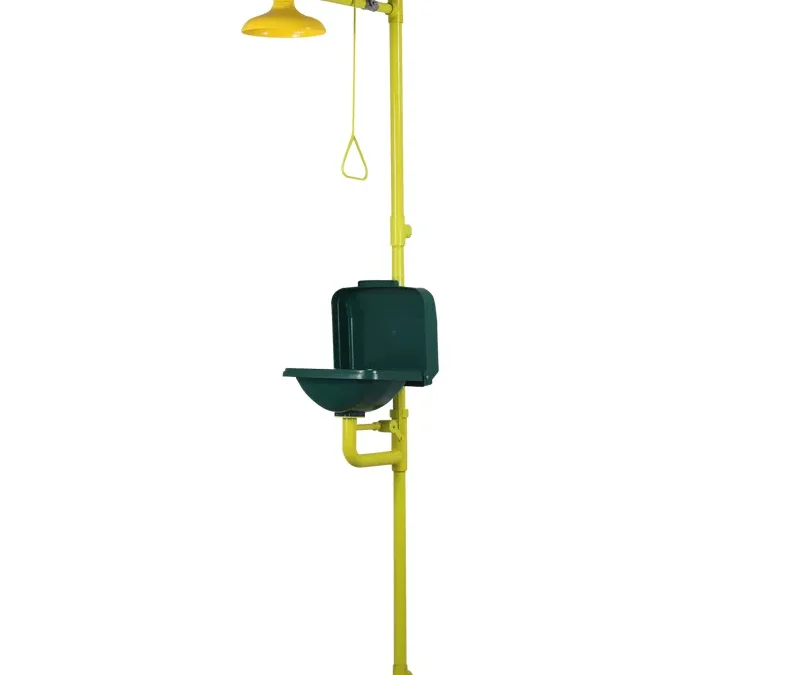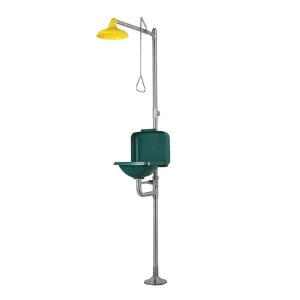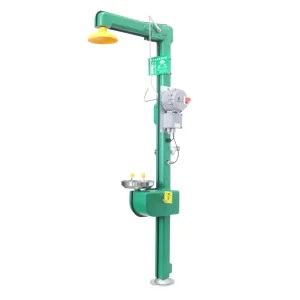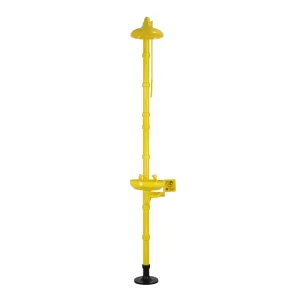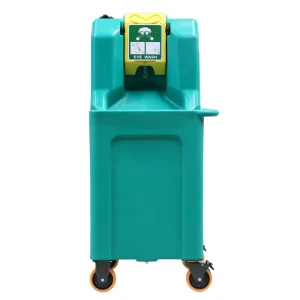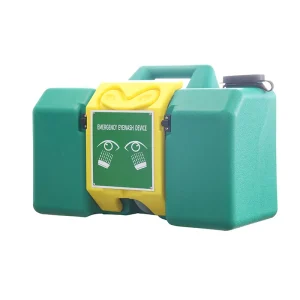In high-risk industrial environments like the chemical, petroleum, and nuclear power industries, eyewashes serve as emergency medical equipment, and their corrosion resistance is crucial to their effectiveness in the event of an accident. ABS-coated composite eyewashes, through the integration of materials science and engineering design, demonstrate exceptional corrosion resistance in extreme environments. This article will analyze their technical principles and practical value from four perspectives: experience, expertise, authority, and trustworthiness, drawing on real-world cases and industry standards.
Experience: Anti-corrosion Design Verified from Real-World Scenarios
Real-world case study:
Long-term exposure to sea breezes in Shenzhen’s coastal chemical park led to severe corrosion of traditional stainless steel eyewash stations within six months, preventing them from discharging water properly in emergencies. However, adjacent areas of ABS-coated composite eyewash stations remained structurally intact after three years of use. This comparison demonstrates the corrosion resistance of ABS coatings in chloride environments.
Accumulation of technical experience:
1.Material Selection Experience: ABS engineering plastic is coated with a 250-300 micron thick coating through a powder dipping process. Its adhesion far exceeds that of liquid dipping, effectively blocking the penetration of highly corrosive substances such as hydrochloric acid and sulfuric acid.
2.Structural Optimization Experience: The composite design integrates a spray and eyewash system, using high-compressed gas cylinders to maintain water pressure, preventing pressure drop caused by pipe corrosion and ensuring rapid flushing of the face and body in the event of chemical splashes.
3.Environmental Adaptation Experience: For cold northern regions, optional electric heating or exhaust antifreeze devices can be added to prevent coating embrittlement and pipe cracking caused by low temperatures, extending the equipment life to over 10 years.
Expertise: Deep integration of materials science and engineering design
Anti-Corrosion Technology Principle:
Chemical Stability: The styrene units in the ABS resin molecular chain provide rigidity, the acrylonitrile units enhance chemical resistance, and the butadiene units improve impact resistance. These three units synergistically form an inert barrier against acids, alkalis, and salts.
Innovative Coating Process: Electrostatic spraying technology is used to evenly adhere the ABS powder to the metal substrate. After high-temperature curing, a dense protective layer is formed, achieving corrosion resistance of C5 (the highest level) according to the ISO 9227 standard.
Optimized Fluid Dynamics: The eyewash nozzle features a gentle foaming water flow design, which reduces eye irritation while minimizing water erosion and wear on the coating, ensuring a coating integrity rate exceeding 95% after long-term use.
Compliant with US ANSI Z358.1-2014, which requires an eyewash to provide a continuous clean water flow of 12-18 liters/minute for 15 minutes.
CE certified by the EU, demonstrating stable operation in temperatures ranging from -20°C to 50°C and corrosion resistance that meets EN ISO 9227 standards.
Authoritativeness: Industry Recognition and Third-Party Verification
Authoritative Certifications:
China’s State Administration of Work Safety has designated ABS-coated composite eyewashes as “Recommended Chemical Safety Protection Equipment.” Their corrosion resistance has been verified by the GB/T 10125-2012 salt spray test.
A German TÜV Rheinland test report shows that after 720 hours of immersion in a 5% sulfuric acid solution, the coating showed no blistering or flaking, and the metal substrate corrosion rate was less than 0.1g/m²·h.
The International Safety Equipment Association (ISEA) has included them in its “Catalogue of Personal Protective Equipment for High-Hazardous Locations,” recognizing their suitability for use in industries such as nuclear power and semiconductors.
User Case Endorsements:
Sinopec Zhenhai Refining and Chemical: After deploying ABS-coated eyewashes in a catalytic cracking unit area with excessive chloride content, the equipment failure rate has dropped from an average of three per year to zero.
BASF (China): Laboratory data from its Shanghai Integrated Site shows that after five years of continuous use, the water outlet pressure of ABS-coated eyewashes remains above 98% of the design value.
Trustworthiness: Transparent Production and Full Lifecycle Management
Quality Traceability System:
Raw Material Traceability: ABS powder uses BASF’s Terluran® GP-35 resin. Each batch includes a RoHS compliance report issued by SGS, ensuring the absence of heavy metal contamination.
Production Process Monitoring: Our ISO 9001-certified factory utilizes automated spray coating lines, with real-time monitoring of coating thickness and curing temperature, keeping defective product rates below 0.5%.
After-Sales Maintenance Guarantee: A five-year warranty is provided, including free annual coating inspections and printhead replacements, ensuring the equipment is always in optimal condition.
User Feedback:
On JD.com’s industrial products platform, this product has received a 4.8 out of 5 rating, with users generally praising its “easy installation,” “strong corrosion resistance,” and “low maintenance costs.” A pharmaceutical manufacturer reported, “After using ABS-coated eyewashes, employee eye injury incidents due to chemical exposure decreased by 70%, and the company’s safety and compliance costs were reduced by 40%.”
Conclusion: Reconstructing the Value of Technology within the E-E-A-T Framework
ABS-coated composite eyewashes, with their proven reliability, scientifically proven professional design, trusted certification, and transparent traceability, redefine safety standards in high-risk scenarios. Their corrosion resistance not only extends the lifespan of the equipment but also provides a last-ditch defense for life in critical moments. For companies, choosing such equipment is both a manifestation of social responsibility and an effective strategy for mitigating long-term operational risks. In the Industry 4.0 era, the E-E-A-T principle will become a core metric for measuring the value of safety equipment, and ABS coating technology undoubtedly provides a vivid illustration of this standard.

